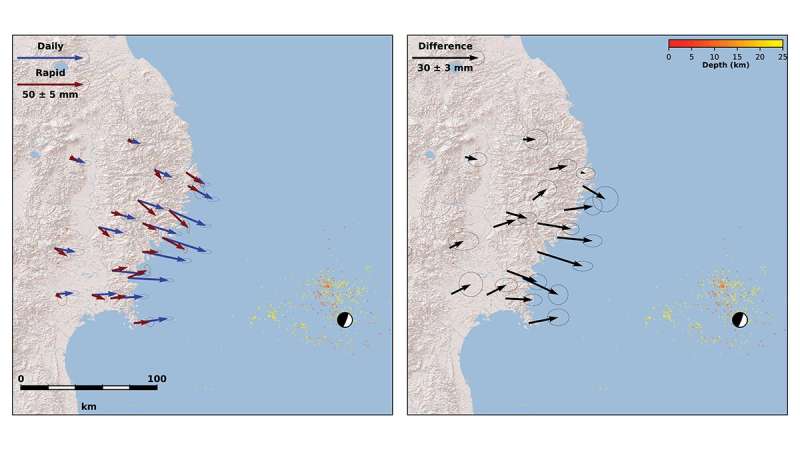Improving coseismic slip measurements

Geologists describe the process of an earthquake as occurring in three distinct phases. During the interseismic phase, strain builds up along a fault as adjacent pieces of crust catch onto one another and move in opposite directions. This strain eventually reaches a breaking point, initiating the coseismic phase, in which the crust gives way and "snaps" to a new position. This snap is what we experience as an earthquake. Additional deformation occurs during the postseismic phase, which can last from minutes to years, as the crust relaxes and returns to the interseismic phase.
Because they happen in rapid succession, distinguishing the boundary between the coseismic and postseismic motions is difficult. Earthquake scientists have two sets of tools for directly observing the motion of an earthquake. Seismic instruments, such as seismographs, record the velocity and acceleration of the movement. Geodetic instruments, such as GPS measurement stations, record displacement (a change in position).
Geodetic instruments make measurements at a cadence; if the interval is too long when used to estimate the magnitude of coseismic slip, the result can erroneously incorporate energy released in the postseismic phase. Golriz et al. develop a physics-based approach to estimating the duration of the coseismic phase in an effort to improve the precision of coseismic slip models and magnitude estimates.
The authors' general method is to use seismic observations to estimate the time window of the coseismic phase and high-frequency (1-hertz) geodetic observations over that window to calculate the crust's change in position. This approach makes the best use of each method's strengths, while minimizing its weaknesses, the authors say.
The onset of coseismic motion is marked by the arrival of the first pressure wave, a clear and commonly observed signal. The authors define the end of a coseismic phase as the time at which a given seismic station has experienced 99% of the total energy it will record for that event. The coseismic period, as a function of distance from the epicenter, enables the authors to use and consider various geodetic observation sites, even if they are not collocated with the seismic stations.
To analyze the effect of this approach, the study considers 10 earthquakes with a variety of morphologies and magnitudes. The authors compare their methodology to more traditional daily geodetic observations and find that their physics-based approach results in significant discrepancies in total crustal motion and energy release. For example, for the magnitude 9.1 Tōhoku-oki event, their approach estimates movement of 5 meters during the coseismic phase, compared with 6.5 meters of movement using the daily observation method. This suggests that historically, a significant amount of postseismic activity has been misclassified as coseismic.
More information: Dorian Golriz et al, Defining the Coseismic Phase of the Crustal Deformation Cycle With Seismogeodesy, Journal of Geophysical Research: Solid Earth (2021). DOI: 10.1029/2021JB022002
Journal information: Journal of Geophysical Research: Solid Earth
Provided by Eos
This story is republished courtesy of Eos, hosted by the American Geophysical Union. Read the original story here.




















